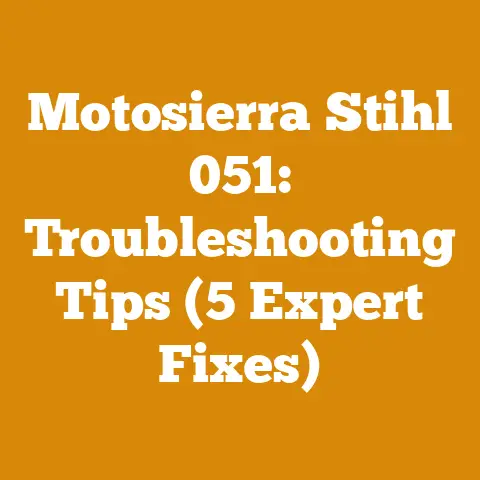Cleaning Creosote from Chimney (5 Pro Tips for Safer Woodburning)
Cleaning Creosote from Chimney: 5 Pro Tips for Safer Woodburning
Maintaining a wood-burning fireplace or stove is more than just stocking up on firewood; it’s about ensuring safety and efficiency. While the crackling fire and cozy warmth of a wood fire are undeniably appealing, the byproduct of burning wood – creosote – poses a significant fire hazard if not properly managed. In this article, I’ll share my experiences and insights, along with actionable tips to keep your chimney clean and your home safe.
Key Takeaways:
- Regular chimney cleaning is crucial to prevent creosote buildup and reduce the risk of chimney fires.
- Understanding the types of creosote helps tailor cleaning methods effectively.
- Professional chimney sweeps offer thorough inspections and cleaning services.
- Burning seasoned wood minimizes creosote formation.
- Proper burning techniques contribute to cleaner and more efficient fires.
Why Creosote Matters: A Personal Encounter
I remember one particularly cold winter when I was just starting out with wood burning. I was so focused on keeping the house warm that I didn’t pay enough attention to the chimney. One evening, I heard a loud crackling and popping sound coming from the chimney. I rushed outside to see flames shooting out of the top! It was a chimney fire, caused by a heavy buildup of creosote.
Luckily, the fire department arrived quickly and extinguished the blaze before it spread to the house. That experience taught me a valuable lesson about the importance of regular chimney maintenance. Now, I make it a priority to inspect and clean my chimney at least twice a year.
Understanding Creosote: The Silent Threat
Creosote is a dark brown or black, oily or crusty deposit that forms inside chimneys and stovepipes when wood is burned. It’s composed of unburned wood particles, gases, and moisture that condense as they rise through the chimney.
The Three Stages of Creosote:
- First-degree creosote: This is a light, flaky soot that is relatively easy to remove.
- Second-degree creosote: This is a more tar-like substance that is harder to remove.
- Third-degree creosote: This is a hard, glazed substance that is extremely difficult to remove and poses the greatest fire risk.
According to the National Fire Protection Association (NFPA), chimney fires are a leading cause of residential fires, and creosote buildup is a primary culprit. The NFPA recommends that chimneys be inspected at least once a year and cleaned as needed.
Pro Tip 1: Schedule Regular Chimney Inspections and Cleaning
The best way to prevent creosote-related problems is to have your chimney inspected and cleaned regularly by a qualified professional. A certified chimney sweep can assess the condition of your chimney, identify any potential hazards, and remove creosote buildup safely and effectively.
How Often Should You Clean?
- At least once a year: Even if you don’t burn wood frequently, annual inspections are essential.
- More frequently if you burn wood regularly: If you use your fireplace or wood stove as a primary heat source, consider cleaning your chimney every three to six months.
- After burning green or unseasoned wood: Green wood produces more smoke and creosote, so cleaning is necessary after burning it.
Finding a Qualified Chimney Sweep:
- Check for certification: Look for chimney sweeps certified by organizations like the Chimney Safety Institute of America (CSIA).
- Ask for references: A reputable chimney sweep will be happy to provide references from satisfied customers.
- Get a written estimate: Before hiring a chimney sweep, get a written estimate that includes the cost of inspection and cleaning.
Pro Tip 2: Choose the Right Firewood
The type of wood you burn significantly impacts creosote formation. Burning seasoned (dry) wood is crucial for minimizing creosote buildup.
Seasoned vs. Unseasoned Wood:
- Seasoned wood: Has been air-dried for at least six months to a year. It has a moisture content of 20% or less. Seasoned wood burns hotter and cleaner, producing less smoke and creosote.
- Unseasoned wood (green wood): Has a high moisture content (over 20%). It burns cooler and produces more smoke, which leads to increased creosote buildup.
Identifying Seasoned Wood:
- Check the color: Seasoned wood is typically gray or brown.
- Look for cracks: Seasoned wood often has cracks or splits in the ends.
- Listen for a hollow sound: When struck together, seasoned wood will produce a hollow sound.
- Use a moisture meter: A moisture meter can accurately measure the moisture content of wood.
Data Point: According to the US Forest Service, burning seasoned wood can reduce creosote formation by up to 50% compared to burning green wood.
My Experience:
I’ve found that hardwoods like oak, maple, and ash are excellent choices for firewood because they burn hotter and longer than softwoods like pine and fir. However, it’s essential to season hardwoods properly before burning them. I usually stack my firewood in a sunny, well-ventilated area for at least a year before using it.
Pro Tip 3: Practice Proper Burning Techniques
How you burn wood can also affect creosote buildup. Proper burning techniques promote cleaner and more efficient fires.
Top-Down Burning:
Top-down burning is a method where you light the fire from the top instead of the bottom. This technique allows the fire to burn more slowly and efficiently, reducing smoke and creosote.
How to Build a Top-Down Fire:
- Place several large logs at the bottom of the firebox.
- Stack smaller pieces of wood on top of the logs.
- Place kindling and a fire starter on top of the stack.
- Light the fire starter.
Hot Fires:
Burning hot fires is another way to reduce creosote buildup. Hot fires burn wood more completely, reducing the amount of unburned particles and gases that contribute to creosote formation.
Ensuring a Hot Fire:
- Use seasoned wood: As mentioned earlier, seasoned wood burns hotter than green wood.
- Provide adequate airflow: Make sure the air vents on your fireplace or wood stove are open to allow enough oxygen to fuel the fire.
- Avoid smoldering fires: Smoldering fires produce more smoke and creosote.
Data Point: Studies have shown that burning hot fires can reduce creosote formation by up to 30% compared to burning smoldering fires.
Pro Tip 4: Use Creosote Removal Products
Several creosote removal products are available on the market, such as creosote sweeping logs and chemical creosote removers. These products can help loosen and break down creosote deposits, making them easier to remove.
Creosote Sweeping Logs:
Creosote sweeping logs contain chemicals that, when burned, release gases that help dry out and loosen creosote deposits. These logs are a convenient way to supplement regular chimney cleaning.
How to Use Creosote Sweeping Logs:
- Follow the manufacturer’s instructions carefully.
- Burn the log in your fireplace or wood stove as directed.
- Allow the chemicals to work for the recommended time.
- After using a creosote sweeping log, have your chimney inspected and cleaned by a professional.
Chemical Creosote Removers:
Chemical creosote removers are available in powder or liquid form. They are applied to the firebox or chimney and help break down creosote deposits.
How to Use Chemical Creosote Removers:
- Follow the manufacturer’s instructions carefully.
- Apply the remover to the firebox or chimney as directed.
- Allow the remover to work for the recommended time.
- After using a chemical creosote remover, have your chimney inspected and cleaned by a professional.
Caution:
- Always wear protective gear, such as gloves and eye protection, when handling creosote removal products.
- Follow the manufacturer’s instructions carefully.
- Do not mix different creosote removal products.
- Keep creosote removal products out of reach of children and pets.
Expert Insight:
According to Bob Vila, a renowned home improvement expert, “Creosote sweeping logs and chemical removers can be helpful, but they are not a substitute for regular chimney cleaning by a professional.”
Pro Tip 5: DIY Chimney Cleaning (With Caution)
While professional chimney cleaning is always recommended, you can perform some basic chimney cleaning tasks yourself. However, proceed with caution and only attempt DIY cleaning if you are comfortable working at heights and have the necessary tools and knowledge.
Tools You’ll Need:
- Chimney brush: Choose a brush that is the correct size and shape for your chimney.
- Extension rods: Use extension rods to reach the entire length of the chimney.
- Drop cloth: Protect your flooring from soot and debris.
- Dust mask: Protect yourself from inhaling soot and dust.
- Safety glasses: Protect your eyes from flying debris.
- Gloves: Protect your hands from soot and creosote.
- Shop vacuum: Use a shop vacuum to clean up soot and debris.
Step-by-Step DIY Chimney Cleaning:
- Prepare the area: Cover the area around your fireplace or wood stove with a drop cloth to protect your flooring.
- Seal the fireplace opening: Use plastic sheeting and tape to seal the fireplace opening to prevent soot and dust from escaping into your home.
- Assemble the chimney brush: Attach the chimney brush to the extension rods.
- Insert the brush into the chimney: Insert the brush into the chimney and push it up and down to scrub the chimney walls.
- Remove the brush: Remove the brush from the chimney and clean it off.
- Repeat the process: Repeat the process until the chimney is clean.
- Clean up the debris: Use a shop vacuum to clean up soot and debris from the fireplace and chimney.
- Remove the plastic sheeting: Carefully remove the plastic sheeting from the fireplace opening.
- Inspect the chimney: Inspect the chimney for any signs of damage or creosote buildup.
Important Safety Precautions:
- Work with a partner: It’s always safer to work with a partner when cleaning your chimney.
- Use a safety harness: If you are working on a roof, use a safety harness to prevent falls.
- Be aware of your surroundings: Watch out for power lines and other hazards.
- Do not clean your chimney during windy conditions: Wind can blow soot and dust into your face and eyes.
- If you are uncomfortable with any part of the process, hire a professional chimney sweep.
Personal Story:
I remember one time when I was cleaning my chimney myself, I got a face full of soot when the brush got stuck. It was a messy and unpleasant experience, and it reinforced the importance of wearing proper safety gear.
Beyond the Basics: Advanced Tips for Creosote Management
While the previous tips cover the essential aspects of creosote management, there are additional steps you can take to further minimize creosote buildup and enhance wood-burning safety.
1. Optimize Your Firewood Storage:
Proper firewood storage is critical for effective seasoning. Stack your wood off the ground to promote airflow and prevent moisture absorption from the soil. Cover the top of the stack to protect it from rain and snow, but leave the sides open for ventilation.
2. Consider a Catalytic Combustor:
If you have a wood stove, consider installing a catalytic combustor. These devices burn off smoke and gases before they exit the chimney, reducing creosote formation and improving heating efficiency.
3. Use a Chimney Cap:
A chimney cap prevents rain, snow, and debris from entering your chimney. This helps keep the chimney dry and prevents moisture from mixing with creosote, which can accelerate its formation.
4. Monitor Chimney Draft:
A strong chimney draft helps carry smoke and gases out of the chimney, reducing the likelihood of creosote condensation. Ensure your chimney is properly sized for your fireplace or wood stove and that there are no obstructions that could impede airflow.
5. Educate Yourself on Wood Species:
Different wood species have varying burning characteristics. Some woods, like oak and hickory, burn hotter and cleaner than others, like pine and poplar. Understanding the properties of different wood species can help you make informed choices about what to burn.
6. Regularly Inspect Your Firebox:
In addition to inspecting your chimney, regularly inspect your firebox for signs of creosote buildup. Look for dark, oily, or crusty deposits on the firebox walls and flue. If you notice significant creosote buildup, it’s time to clean your chimney.
7. Consider an EPA-Certified Wood Stove:
EPA-certified wood stoves are designed to burn wood more efficiently and produce less smoke and creosote. These stoves have advanced combustion technologies that help reduce emissions and improve air quality.
8. Keep Your Chimney Liner in Good Condition:
A damaged or deteriorated chimney liner can allow creosote to seep into the chimney structure, increasing the risk of fire. Regularly inspect your chimney liner and repair any cracks or damage promptly.
9. Be Mindful of Airflow:
Proper airflow is essential for efficient wood burning and creosote reduction. Ensure that your fireplace or wood stove has adequate airflow and avoid blocking the air vents.
10. Document Your Chimney Maintenance:
Keep a record of all chimney inspections, cleanings, and repairs. This documentation can be helpful for insurance purposes and can also help you track the condition of your chimney over time.
Case Study: The Impact of Wood Moisture Content on Creosote Formation
A study conducted by the University of Maine investigated the impact of wood moisture content on creosote formation in residential wood stoves. The study found that burning wood with a moisture content of 30% or higher resulted in significantly higher creosote buildup compared to burning wood with a moisture content of 20% or less.
The study also found that burning green wood increased the risk of chimney fires. The researchers concluded that burning seasoned wood is essential for minimizing creosote buildup and ensuring safe wood burning.
Data Point: The study found that burning wood with a moisture content of 30% or higher resulted in a 50% increase in creosote buildup compared to burning wood with a moisture content of 20% or less.
Expert Quote:
According to John Gulland, a certified chimney sweep with over 20 years of experience, “The most common mistake I see homeowners make is burning unseasoned wood. It’s crucial to burn seasoned wood to minimize creosote buildup and prevent chimney fires.”
Final Thoughts: Prioritizing Safety and Efficiency
Cleaning creosote from your chimney is not just a chore; it’s a critical safety measure that protects your home and family. By following the pro tips outlined in this article, you can minimize creosote buildup, reduce the risk of chimney fires, and enjoy the warmth and comfort of a wood-burning fire safely and efficiently.
Remember, regular chimney inspections and cleaning are essential, and DIY cleaning should only be attempted if you are comfortable working at heights and have the necessary tools and knowledge.
Actionable Steps:
- Schedule a chimney inspection with a certified chimney sweep.
- Ensure you are burning seasoned wood.
- Practice proper burning techniques.
- Consider using creosote removal products.
- If you choose to clean your chimney yourself, follow safety precautions.
By prioritizing safety and efficiency, you can enjoy the benefits of wood burning without the risks associated with creosote buildup.






